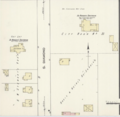Norbury Sanatorium
| The Norbury Sanatorium | |
|---|---|
 | |
| Established | 1901 |
| Opened | 1901 |
| Closed | 1960s |
| Current Status | Closed |
| Building Style | Cottage Plan |
| Location | Jacksonville, IL |
| Peak Patient Population | 125 |
| Alternate Names |
|
HISTORY[edit]
Dr. Frank Parsons Norbury (1863 – 1939) founded The Norbury Sanatorium in 1901 in Jacksonville, Illinois, for the treatment of nervous and mental diseases. Dr. Norbury wanted to establish a more defined and individual private care for patients having mental and/or nervous disorders who could not be received in general hospitals or receive proper care at home.
Dr. Norbury graduated from Long Island College Hospital, Brooklyn, in 1888. His began his medical career as a resident physician on the staff of the Pennsylvania Training School for Feeble-Minded Children at Elwyn. He focused his graduate work in neuropathology and clinical neurology. He then became a resident staff of the Illinois Central Hospital for the Insane (now the Jacksonville State Hospital), where he served for five years. In 1893, decided to go into private practice and became an attending physician at Oak Lawn Retreat, a private institution for mental and nervous diseases before opening the Norbury Sanatorium.
The sanatorium began in a single building with accommodations for fifteen patients at a Southern Colonial style home on 806 South Diamond Street. The home was remodeled to meet the requirements of hospital service and room for fifty patients. The first patient was admitted on August 11, 1901.
The sanatorium quickly outgrew the property on South Diamond Street and expanded to a neighboring property on 1631 Mound Avenue. This building, called “Maplecrest,” was also remodeled to four units containing 10 rooms each and private baths. Maplecrest housed the female patients and administrative offices, while the original sanatorium building, now called “Maplewood,” housed male and custodial patients. Hydrotherapy, electroshock therapy, occupational therapy, X-rays, and diathermy (a medical and surgical technique involving the production of heat in a part of the body by high-frequency electric currents, to stimulate the circulation, relieve pain, destroy unhealthy tissue, or cause bleeding vessels to clot) were located in Maplecrest's sub-basement.
A diagnostic clinic was also established at the Norbury Sanatorium. Reports from the diagnostic clinic were shared with family physicians, public schools, social agencies, and juvenile and criminal courts, and was focused on making recommendations for the care of children suffering from mental and nervous disorders.
Maplecrest sat on 31 landscaped acres. Additional buildings included a nurses’ home, heating plant, and laundry. Recreation was offered to both male and female patients. The sanatorium grounds included tennis courts, orchards, gardens, and a chicken farm.
Nurses employed at Norbury Sanatorium were first sent to train in cities such as Philadelphia, Boston, and Baltimore in order to study “most modern technic and facilities offered in the specialized services in those medical centers.”
Mentions of the sanatorium in medical publications and newspapers were difficult to find after the early 1960s. A 1967 newspaper notes the sale of the property, so it seems the sanitorium closed in the mid-1960s, though an exact year is unknown. The Maplecrest building has since been demolished and its acreage sold off. The Maplewood building on South Diamond Street still stands, it’s outward appearance reminiscent of its original purpose, and is now an apartment building.






